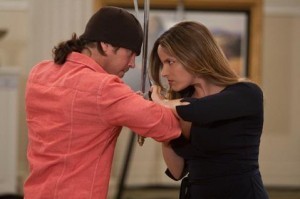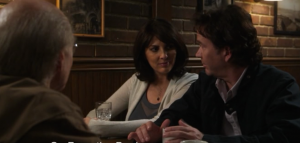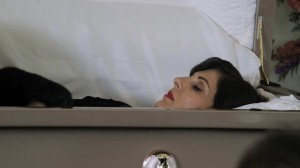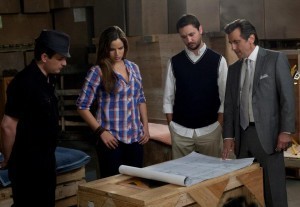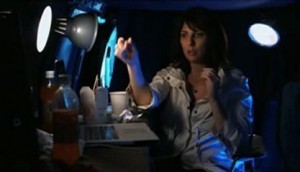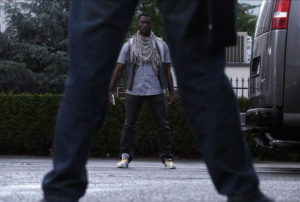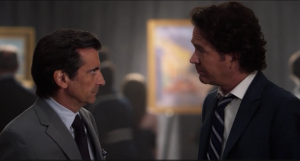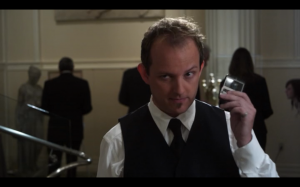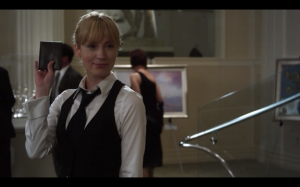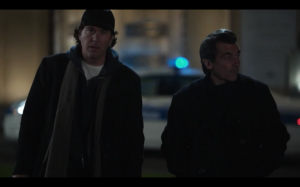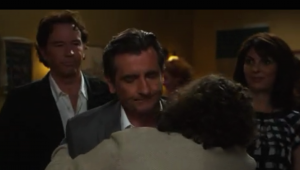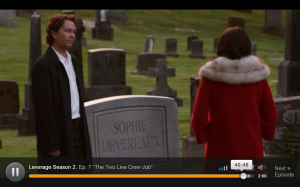Leverage Sunday: The Two Live Crew Job: Foils and Dopplegangers
Before we get to Leverage, let’s talk about foils and doppelgängers.
A foil, in literary terms, is a character who stands in comparison to another character, and by contrast, illuminates the second character. It takes its name from the jeweler’s practice of backing their diamond cases with foil to make the gems shine brighter, but in fiction it’s done to deepen the reader or viewer’s understanding of character. Take Macbeth and Banquo, for example (because their my favorite example).
At the start of the play, Macbeth and Banquo are much the same character, brave generals who have just won a victory for a king they’re loyal to. Enter the witches with prophecies for both; Banquo rejects his prophecy to stay loyal to his king, Macbeth goes home and tells the wife about his and it’s all downhill from there. Midway through the third act of this five-act play, after Macbeth has murdered his way to the crown, he invites Banquo to share in his success, promising him titles and riches, and Banquo tells him he doesn’t want anything that was not gotten honestly. So Macbeth has him killed. This might seem an over-reaction to an imprudent lack of tact, but not when you take into consideration that Banquo has become Macbeth’s foil. Macbeth can justify his actions to himself only as long as he’s not looking at the man he used to be, the man he can never be again. Macbeth knows he’s going to hell for his crimes, and it doesn’t help in the slightest looking at Banquo, clearly being fitted for angel’s wings. The only way Macbeth can keep from going crazy with guilt and regret is to kill Banquo. That’s the power of the foil.
A doppelgänger, on the other hand, is less literary and more folklore and legend-based. A doppelgänger (“look-alike”) is a character’s shadow-self, usually evil, which is why antagonists are often doppelgängers. For example, at the beginning of Raiders of the Lost Ark, Indiana Jones is stealing a religious icon from a South American tribe, ignoring the fact that he’s damaging the spiritual life of others; his Nazi doppelgänger Belloq immediately steals it from him. Jones is Good and Belloq is Bad, but as the opening makes clear, they’re the same culturally insensitive looters, spiritually bankrupt doppelgängers.
The difference, then, between the foil and the doppelgänger is that the foil provides a contrast (the foil’s presence in the narrative actively does something for the story), but the doppelgänger is just a psychological double, a character attribute. Therefore, the key to making the doppelgänger antagonist work in the narrative is to use him or her as a foil. That is, the plot of a story begins on the Day That Is Different for the protagonist, the day that he begins to change and his character begins to arc because events are blowing up in his face. But while the protagonist begins to change on that day, the doppelgänger antagonist does not, which means that at the end of the story when they meet at that final obligatory climactic scene, the reader can look at the protagonist and the antagonist and clearly understand how much the protagonist has changed because who he was to begin with is standing right there beside him. So Indiana Jones lets Belloq take the ark to save the woman they both love, and then tells her, “Don’t look,” when Belloq opens the ark because he knows now that the spiritual dimension of life is unknowable and powerful beyond words and should be left to the people who believe in it and understand it. Because of that, Jones gets both the girl and the ark; if that scene had been played at the beginning of the story, he’d be the same gruesome puddle of bleah that Belloq ends up as.
Which brings us to “The Two Live Crew Job,” one of the best use of doppelgängers as foils I’ve ever seen on the screen. The premise is both simple and elegant. The Leverage team comes up against the team they used to be: a hitter, a hacker, and a thief, loners brought together by a mastermind for one job. If you cast your mind back to the pilot, you’ll remember that Nate was the mastermind who worked with a team of loners for one job only. Nate and Stark are doppelgängers, but that’s only important in the story because Stark is such an excellent foil for Nate, just as Stark’s team is an excellent foil for Nate’s community.
Inciting Event: “Let’s Go Steal A Painting”
The episode starts out the same as always, good people harmed by bad men with money, in this case a software developer without a conscience. The team sets out to steal a painting from him, only to find another team, the Evil Team, has been there before them. As our team regroups from the setback, they’re hit with another disaster, Sophie is trapped in her apartment, holding a bomb with a motion sensor trigger. The team first refuses to leave and finally goes only when Sophie tells them to get out; Nate still refuses to leave and even when Sophie makes him, stays outside, his shadow plain on the open door, as Sophie drops the bomb and runs. Lost in all the tension around the bomb is one important fact: The team had a member who was about to die, and they stuck by her; they’ve come a long way since the pilot episode.
The next scene is Sophie’s funeral, or rather the funeral of Katherine Clive, her alias in Boston. Eliot, Parker, and Hardison each say something that reflects how the team has become family–Hardison’s “Sometimes friends are the only family you have” is especially poignant–even though Eliot and Hardison know she’s not dead (Parker’s a little unclear on that). Then a stranger comes up to Nate and expresses his sympathy, and Sophie, not the kind of person to miss her own funeral, recognizes him as Marcus Stark, a partner-in-crime from her past. Back at the apartment, Hardison says, “You saw another team before us?” but Eliot gets to the point as Nate goes into overdrive in his determination to defeat Stark: “What bugs you more, is it the fact that he was with Sophie first or that he outsmarted you?”
Then Sophie fills in the important detail: Stark puts together a temporary team when he works. That means that although the scene immediately goes into a crosscut with Nate and Stark as doppelgängers talking to their teams in the same way, Stark’s team will always be a foil for Nate’s team because Stark’s team is temporary and Nate’s team is family. The fact that Nate and Stark are doppelgängers makes the scene fun, but the fact that the teams are foils makes the scene important.
Change of Plans: “He’s Going To Come Up With a Bigger, Riskier Plan”
As they go into action, Sophie’s stuck in the van with Hardison, who tells her at one point, “We trust Nate to make sure the plan works; we trust you to make sure we’re okay.” It’s a nice moment, but it’s also a foil moment: Stark’s crew has a mastermind/grifter, a hacker, a hitter, and a thief, but it doesn’t have a Sophie, it’s short one crucial member, the one who makes sure that everyone’s okay, because Stark doesn’t care that everyone’s okay.
Meanwhile, Hardison, Eliot, and Parker all meet their opposite numbers and are either defeated or retire from a stalemate: Parker meets Apollo (Apollo Robbins in his first acting role; he’s the pickpocket who trained Beth Reisgraf to do lifts, and all of the lifts in the episode are real including that flipping-the-tray bit); Eliot meets Mikel Dayna (played by Noa Tishby, who really was once in the Israeli army; their imaginary battles are played out as B kung fu movies complete with scratched film), and Hardison meets Chaos (played by Wil Wheaton who makes a great jerk as the two of them do a Nerd High Noon).
Reeling from their checkmate by the other team, Our Guys go back to the apartment to regroup as Nate starts to lose it. When Eliot asks Sophie how things are going to play out, she says, “He’s been challenged, his ego’s been hurt, he’s going to come up with a bigger, riskier plan,” and Eliot has to ask for clarification: Is she talked about Nate or Stark? She says Nate, but it’s clear that they’re both reacting in the same way, as the story goes to cross cuts again, switching between Nate and Stark as they talk to their teams in the same way, move in the same way, fueled by the same angry intensity, two men who are the same man: our doppelgänger protagonist and antagonist. (Every time I see this scene, I’m amazed all over again at how cleanly, clearly, beautifully, they establish that while making it fun to watch.) The last line–”Let go steal/ourselves a masterpiece” is split perfectly between the two and kicks off the third act.
Point of No Return: Let’s Go Steal Ourselves a Masterpiece
That third act is just a good time as the opposite numbers meet again and engage (Parker and Apollo talk birds, Eliot and Mikel beat each other up as foreplay), especially when Nate’s drunk act is interrupted by Stark, dressed like Nate, introducing himself as Nate. That makes Stark the new Evil Nate (sorry, Sterling), the doppelgänger made flesh as he steals Nate’s life. “You all out of tricks, Nate?” he says, gloating as a police car pulls up.
Crisis: “You All Out of Tricks, Nate?”
But it’s all part of Nate’s plan as Hardison goes to backup power, Parker arrests Apollo, Eliot kisses Mikel and snaps handcuffs on her, and Sophie gets out of the cop car. Nate wins, but he has a big advantage, a coordinated team, a community that knows each other well and can play off each other, while all Stark has are employees, and one of those is trying to kill him. Because his team is a community, Nate owns Stark at the end of the third act, having taken two members of his team (as Parker plays pick-the-lock with Apollo and Eliot and Mikel compare scars and foreplay with handcuffs) and sent the third on the run.
Climax:
Nate offers Stark a deal: his people in trade for the first painting he stole, the one they need for their clients. Stark’s reply is perfect foil-speak: “Do I look like Moses? They’re not my people.” What he will trade for is the Van Gogh. Nate’s coup de grace is forcing Stark to become Nate Ford the Good Guy as he hands back the painting, something that clearly pains Stark. Then they send him off with one of his own fakes, and use the rest of the fakes and the real painting to have Chaos arrested at the airport.
Stark gets in one last dig at Sophie–”You know, the Sophie Devereaux I knew would never have wasted time like this. What happened to her?”–and thereby does double duty as her foil, too. Sophie says, “She died, remember?” underscoring the fact that the Sophie that Stark worked with is not the Sophie who’s part of the Leverage team. Seeing Stark now throws the huge changes in Sophie’s life into relief, and so she walks away from the team at the end of this episode to find out who she is. That’s where this episode goes off the rails for me. I have huge sympathy for the show runners who had to deal with Gina Bellman going off on pregnancy leave, but in terms of story, Sophie’s departure says that the team isn’t that important to her. They did set up her exit in a previous episode when Sophie’s boyfriend leaves her because he knows she’s not being honest with him, but within the world of the story, it still comes down to Sophie leaving a team she cares about for selfish reasons. One thing the commentary cleared up for me: Sophie evidently bought the new tombstone that said “Sophie Devereaux” in order to symbolically bury that identity, but then she keeps it until the end of the series. So, huh? But that’s a quibble, and the rest of the episode is so good, I just pretend that last scene never happened.
What this episode does for the Leverage community is show not just how strong they are together, but how much they’d be missing if they weren’t a team. It’s a brilliant use of the doppelgänger as foil, emphasized not only in dialogue but in character, like Parker and Apollo’s interest in technique and Hardison and Chaos’s bombastic arrogance, in settings like Hardison and Chaos’s matching vans, in the echoes in the costuming for Parker and Apollo and Nate and Stark, and in the camera work and set up, as when Nate moves right to left and then the camera cuts to Stark moving left to right, subliminally setting Stark up not as Nate’s duplicate, but his mirror image, the dark to his light. And while the story is doing all of this subtext and metaphor, up on the surface it’s telling a fast-paced, funny story about terrific characters doing amazing things. It’s very hard to make good, complex storytelling look this easy, let alone this much fun to watch.
End note:
BIG thanks to whomever it was who kept saying that the commentary on the DVDs was worthwhile. This is the only episode I’ve watch with commentary so far, but I’ll be watching all five seasons again just to get the extra background. My fave thing from this episode: the idea of “competence porn,” the thrill we get from watching people who are good at their jobs.


